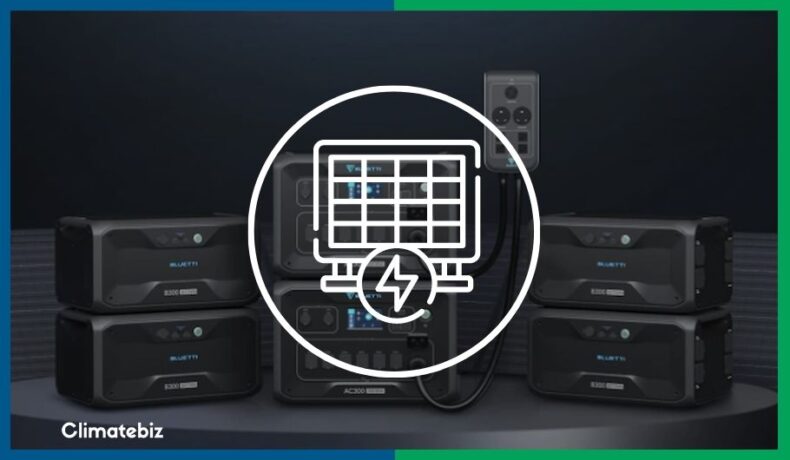“Do I need a solar generator for my house?”
If there’s one thing most people can agree on, it’s that electricity is a basic need. It helps us power anything from everyday appliances such as smartphones and TVs to truly essential medical equipment and food storage systems.
It’s therefore understandable why suddenly finding yourself without power is frightening — luckily, we have solar generators to provide energy in these emergencies.
Unlike traditional gas-powered generators, solar generators use a renewable, abundant, and free energy source to generate electricity — the sun.
These solar generators are rapidly becoming popular off-grid energy solutions due to the advancements in portable solar panel technologies. You can use them to power RVs, off-grid cabins, and small devices during camping trips.
Due to their many advantages, it’s only natural to wonder: can solar generators power a house?
This article will provide an in-depth overview of solar generators for houses. We’ll discuss their ability to power an entire house, their average cost, how to maintain them, and much more.
Finally, we’ll show you some of the best high-capacity solar generators on the market today.
Let’s dive right in!
Table of Contents
Can a Solar Generator Power a House?

While a solar generator is capable of, say, powering numerous camping trip gadgets, it isn’t made to sustain the demands of an entire house.
U.S Household Energy Consumption
According to a report published by the Energy Information Agency (EIA) in 2020, the average energy consumption per household in the U.S. is 893 kWh per month. That’s approximately 29kWh per day, or 1.24 kWh per hour — which is a lot.
In fact, the U.S. is the second-largest consumer of electric energy globally, losing only to China.
With that said, for a solar generator to power an average U.S. household for, let’s say, six hours, it would need to provide 7,44kWh.
While most solar generators cannot provide that much energy (as they generally range from 500 Wh to 1000 Wh in capacity), some generator models are modular. This feature considerably increases the generator’s capacity, making it a viable option as home backup power supply.
Rare Occurrences
Additionally, it’s important to remember that solar generator for houses are used for rare occurrences, like during a blackout. In these instances, energy consumption needs would be lower than normal circumstances.
Think about it like this — during a blackout, you probably wouldn’t use your generator to power your washing machine or dishwasher; you would save your limited energy for more necessary appliances (unless your solar generator could sustain your entire house).
Factors To Consider
To determine whether or not a solar generator can power your house, consider the following:
- What is your households energy demand (in the event of a power outage or any other occasion in which you would want to use your solar generator)?
- How many hours would you need to have backup energy?
- Besides energy (in Wh), how much power (in W) do you need?
- Is there a solar generator that can meet your energy requirements?
These questions can be overwhelming, but don’t worry; we’ll walk you through each one of these steps.
What Are Solar Generators?
Solar generators are devices that can harness power from the sun, storing clean energy, which you can use in times of need (like during a blackout).
They are pretty versatile, providing several AC outlets, 12V DC carports output, and USB ports, all of which allow you to power multiple devices simultaneously. Additionally, they’re available in many sizes and capacities, so there’s a solar generator for every need.
Solar generators are quiet and low-maintenance devices. The main downside is their high upfront cost.
However, they can help reduce your electricity bill; you can charge your solar generator during off-peak hours (when the electricity price is lower) and use it during peak hours.
Key Components
In order to provide all of these features, solar generators for homes need to be an “all-in-one” device. They are equipped with:
- Solar battery: usually lithium-ion, because they are lightweight.
- Charge controller: regulates the voltage applied to the battery. That’s because you can charge your solar generator using different methods: solar, AC charging, 12V DC carport etc. So a charge controller is necessary to control the many different inputs the solar generator supports.
- Inverter: converts the direct current (DC) provided by the battery, into alternating current (AC), which is what most appliances and devices use.
Estimating Your Energy Demand
The first thing you’ll need to do is determine the appliances you wish to power with your solar generator.
Each appliance has its voltage (in volts) and current (in amps) specifications. Once you know these values, you can calculate your appliance’s power rating, using:
Power (W) = voltage (V) x current (A)
Once you’ve calculated the power requirements of your devices, you need to determine the amount of time (in hours) you wish to run each appliance.
For instance, a fridge is an indispensable household appliance, so you should consider its energy demand.
Let’s say you want your solar generator to run your fridge for at least five hours. — the average power rating of a regular-size fridge is around 450W. So the total energy demand of your fridge would be:
Energy demand (Wh) = power (W) x hours of autonomy (h)
Energy demand (Wh) = 450 W x 5h = 2250 Wh
There you have it — to run your fridge for five hours, you’d require a solar generator with a capacity of at least 2250 Wh.
You can use the same calculation (as we showed for the fridge) to determine the total amount of watt-hours you’ll need to guarantee your solar generator backs up your house.
Finding The Right Solar Generator For Your House
After you’ve calculated your energy demands (in Wh) to get through a blackout, you can begin searching for a generator with features that best suit your homes needs.
Let’s say you’ve calculated a total amount of 6100 Wh; you’ll need to find a solar generator that can provide a bit more than that. Why? Because you need to consider the recommended depth of discharge (usually 80% for LiFePO4 batteries) and the inverter’s efficiency to convert DC into AC.
Don’t risk running out of backup power by getting a solar generator with a capacity equal to your energy demand — always account for efficiency losses.
Moreover, solar generators come with different features (like input and output options), so knowing your preferences can really speed up your selection process.
How Much Do Solar Generators For Homes Cost?
Your upfront investment will be proportional to the number of watt-hours you require.
Suppose your goal is to power only a few essential appliances — a phone charger, lightbulbs, fridge, and stove — for a few hours until your grid power returns. In that case, a medium-size capacity solar generator will do the trick.
Solar generators in this category usually offer between 3 kWh and 5 kWh, and their price ranges from $2,000 to $6,000.
However, if you’re looking to power multiple appliances simultaneously for many hours (or even days), only a high-capacity solar generator system with expandable battery units will meet your requirements.
High-capacity solar generators for homes can be obtained by adding compatible battery extension modules. This setup can offer between 9 kWh and 12 kWh (some options can be expanded to provide an amazing 24 kWh). In this case, your investment could range from $10,000 to $20,000.
Which Solar Generators Are Best For Houses?
Below we’ve selected the 4 best solar generators for house usage:
1. BLUETTI EP500 Solar Generator

Tech Specs:
| Continuous power output | 2000W Pure Sine Wave Inverter (or 3000W for PRO version) |
| Power surge | Max surge of 4000W (or 6000W for PRO version) |
| Capacity | 5100Wh |
| Expandable Capacity | Can be paired with an equal unit to achieve 10.2kWh total or 11,2kWh, for PRO version (requires extra accessories) |
| Battery Chemistry | Lithium Iron Phosphate |
| Battery Life Cycle | 6000 cycles until 50% capacity |
| Charging Methods | Solar, Wall Outlet, Car charging, Generator |
| Maximum Solar Input | 1200W |
| Split-Phase Function | Yes, by pairing two units |
| Output Options | USB-C, USB-A, AC, DC, RV Port 30A (adapter sold separately) , Wireless Charging Pad |
| Warranty | 3 years |
Product Overview:
The BLUETTI EP500 model makes single application energy storage systems, such as a Tesla Powerwall, a thing of the past.
- Capacity: this class-leading solar generator can run your whole house for a day or two in the event of an unexpected outage. Providing 5120Wh with a 2000W pure sine wave inverter.
- Solar Charging: you can use third-party solar panels to charge your EP500 unit, as long as the maximum input current is 20A and the charging voltage is between 55-145V. EP500 can achieve a maximum of 1200W solar input.
- Split-Phase Function: for “power-hungry” loads, users can connect two EP500 unit to form one power system with double the available output power, voltage, and capacity.
2. EcoFlow DELTA Pro Portable Power Station
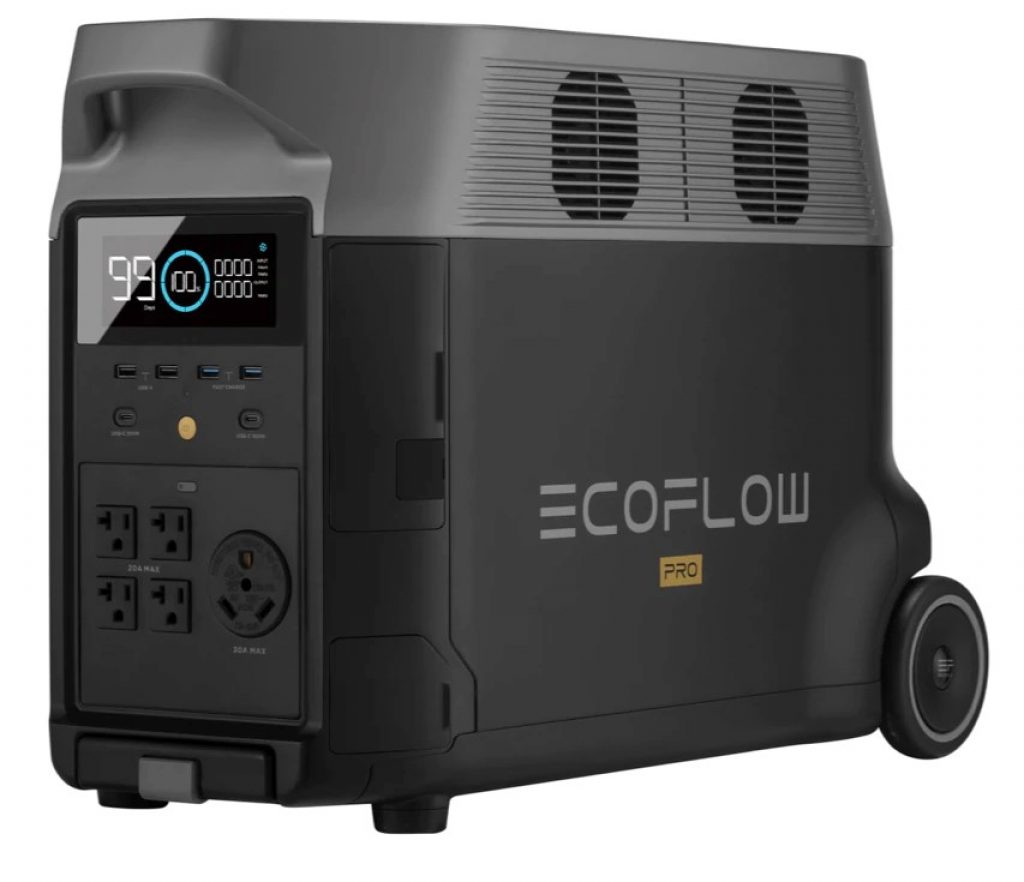
Tech Specs:
| Continuous power output | 3600W |
| Power surge | 7200W |
| Capacity | 3600Wh |
| Expandable Capacity | Supports up to two extra batteries, 3.6kWh each |
| Battery Chemistry | Lithium Iron Phosphate |
| Battery Life Cycle | 6,500 cycles to 50% capacity, 3,500 cycles to 80% capacity |
| Charging Methods | Solar, Wall Outlet, Car charging, EV Charging Station |
| Maximum Solar Input | 1600W |
| Split-Phase Function | Yes, by pairing two units |
| Output Options | AC, DC, USB-A, USB-C, RV port, Car Power Output |
| Warranty | 2 years |
Product Overview:
The DELTA Pro model from EcoFlow is advertised as “a portable home battery with an expandable ecosystem for home backup”, and this description is spot on.
- Capacity: with 3.6kWh of capacity (from its LiFePO4 battery) and 3600W of power, it can power pretty much any appliance. And there’s more: you can expand this by adding two extra batteries, bringing you up to a total of 10.8kWh. In addition, you can pair two units (with additional batteries in each) to achieve groundbreaking 25kWh of capacity.
- Home Integration: for convenience, you can integrate this generator directly with your home circuits using the Smart Home Panel (sold separately).
- Split-Phase Function: tt supports split-phase bonding, meaning you can pair two units together (using a “double voltage hub”, sold separately) to power 240V appliances and achieve a massive power of 7200W.
- Charging Methods: you can recharge it using several different methods: solar panels (max input of 1600W), 240V outlet (max 3000W input), EV charger (3400W input), smart generator, and smart home panel (both sold by EcoFlow).
- Dual Charging Option: you can use three charging methods (AC + solar + smart generator from EcoFlow) simultaneously, with a total input rate of 6500W. This way, it fully charges in 1.8 hours.
3. Point Zero Energy Titan Solar Generator
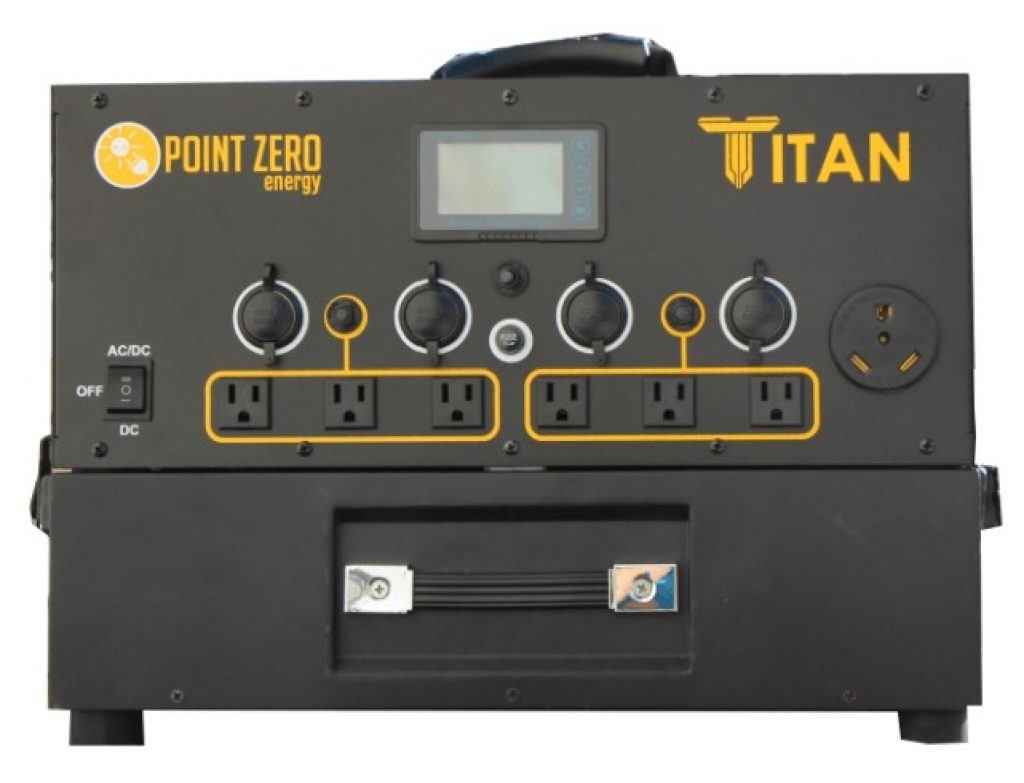
Tech Specs:
| Continuous power output | 3000W (with 2+ battery packs) |
| Power surge | 6000W |
| Capacity | 2000Wh |
| Expandable Capacity | Supports up to 6 extra batteries, 2kWh each |
| Battery Chemistry | Lithium-Ion |
| Battery Life Cycle | Up to 2000 cycles (with 80% DoD) |
| Charging Methods | Solar, AC charger |
| Maximum Solar Input | 2000W |
| Split-Phase Function | No |
| Output Options | AC, DC, RV port |
| Warranty | 2 year limited on Titan Power Module 1 year limited on Titan Battery Pack |
Product Overview:
The Titan solar Generator from Point Zero Energy provides reliable solar backup power for any situation.
- Power Inverter: it has a powerful built-in 3000W inverter (with 6000W surge), which allows you to power high-wattage appliances.
- Expandable Capacity: it comes with a 2000Wh lithium battery pack, but the best feature of this solar generator is that its battery system is completely expandable, so you can add multiple 2000Wh battery modules to expand your system’s energy capacity (it’s recommended a maximum of 6 batteries).
- Solar Charging: it has two MPPT charge controllers, which can handle up to 1000W of solar input each (2000W total). This way, you can quickly recharge the batteries using solar panels.
4. BLUETTI AC300 + B300 Battery Modules

Tech Specs:
| Continuous power output | 3000W |
| Power surge | 6000W |
| Capacity | Minimum of 3072Wh |
| Expandable Capacity | Expandable with up to 4 battery packs (B300) to achieve 12,288Wh |
| Battery Chemistry | Lithium Iron Phosphate |
| Battery Life Cycle | 6000 cycles until 50% capacity |
| Charging Methods | Solar Panels, Car charging, Wall Outlet, Wind Turbine, Generator, EV station |
| Maximum Solar Input | 2400W |
| Split-Phase Function | Possible pairing two AC300 units (requires extra accessories) |
| Output Options | USB-A, USB-C, RV Port 30A (adapter sold separately), AC, 12VDC, 24VDC, Wireless Charging Pad |
| Warranty | 4 years |
Product Overview:
Perhaps the best solar generator for a home, the BLUETTI AC300 is entirely modular, so you can extend its capacity by adding BLUETTI B300 battery modules.
- Expandable Capacity: each AC300 unit accepts up to 4 BC300 battery modules (3,072 Wh per pack). This amounts to a total of 12,288 Wh.
- Split-Phase Function: you can connect two AC300 units in series with the BLUETTI Fusion Box Pro and connect up to 8 battery modules (four per AC300 unit). With this setup, you get a 240V voltage, 6000 W (3000 W pure sine inverter in each AC300 unit) of power, and a groundbreaking total of 24,576 Wh energy capacity! This amount of energy can power your house for almost 3 days, depending on your energy consumption.
- Solar Charging: the AC300+B300 supports two PV inputs and can achieve a combined maximum of 2400 W of total solar input. Moreover, when you expand the system’s capacity (by adding B300 battery unit), the max solar input increases.
Where In Your House Is It Best To Keep Your Solar Generator?
Unlike traditional gas-powered generators, solar generators don’t release any harmful fumes, nor are they prone to flammable oil spills (or any other toxic substances).
Furthermore, solar generators aren’t as noisy as gas-powered generators (which make a lot of noise because they generate electricity through an alternator).
Conversely, solar generators get their power from solar panels and store it as chemical energy (in solar batteries). When needed, the battery converts the chemical energy into electrical energy. This process doesn’t produce any sound whatsoever.
The only sound originating from solar generators is the sound of the internal cooling fan, which kicks in to avoid any overheating risks (present in some solar generator models). However, this fan noise is comparable to that of a computer CPU cooling fan, so it isn’t very disturbing.
For these reasons, you can keep your solar generator inside your house, near your appliances, pretty much wherever most convenient.

Source: bluettipower.com
For convenience, you can even use a generator transfer switch to connect your solar generator directly to your house’s electrical panel.
You can also keep it in outdoor areas (if the weather allows), to run appliances in your backyard.

Source: bluettipower.com
In conclusion, there aren’t limitations as to where you can keep your solar generator. They are highly safe and reliable devices.
Should A Solar Generator For A House Support Split Phase Bonding?
It depends on how you intend to use your solar generator.
The split-hhase power system is common in North America for residential applications. With this system, you have the option to pull 120 VAC between a hot wire and neutral, or 240 VAC from two 120V hot wires.
Low and medium power appliances use 120V outlets, while high-power appliances (window A/C unit, clothes dryer, water heater, etc.) usually use 240V outlets (to reduce electric shock hazard or electromagnetic noise).
Therefore, if you want a solar generator for the sole purpose of powering essential appliances during a power outage, then there’s no need for this generator to support split-phase bonding. A 120VAC system should be enough to power the essentials.
However, if you want to power a variety of appliances, including those that require a 220V input, then your solar generator should support split-phase bonding.
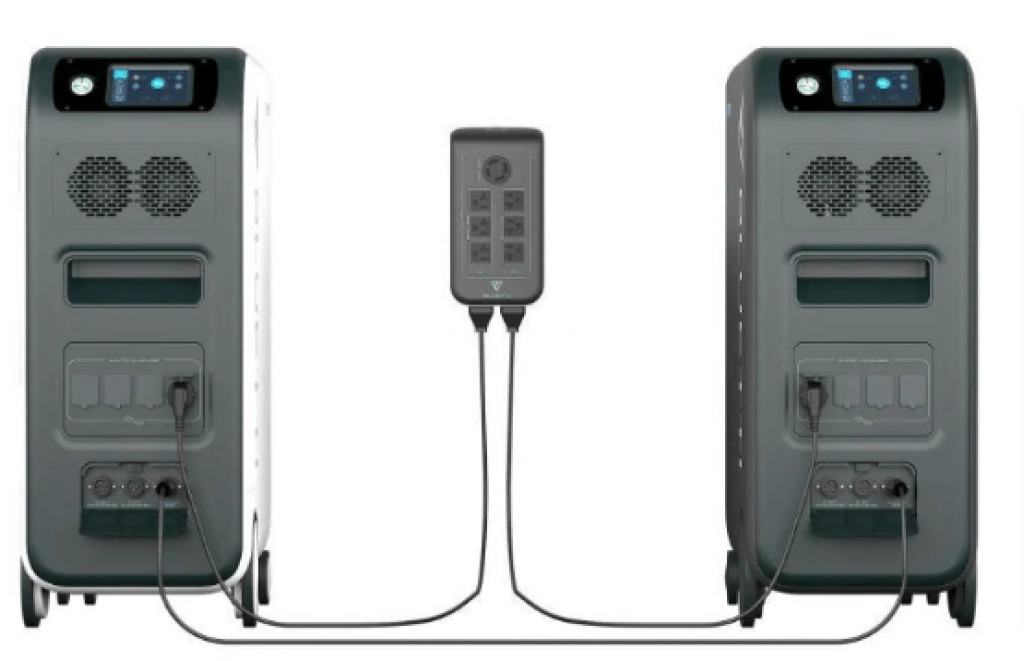
Source: shopsolarkits.com
There are a number of solar generators for household usage that support split-phase bonding.
Good examples are the BLUETTI EP500 and the EcoFlow DELTA Pro.
How Can You Recharge Your Home’s Solar Generator Fast?
The most significant advantage of solar generators is that they can be recharged with solar energy.; recharging can take about 6 to 8 hours, depending on the generators capacity and recharge rate
However, solar generators for homes can withstand a very high input rate, meaning you can charge them even quicker.
For example, the aforementioned BLUETTI AC300 (plus the B300 battery power system) supports a maximum of 3000 W AC charging from a wall outlet, and up to 2400 W max PV charging from solar panels.
These high-capacity solar generators also come with a fantastic dual charging feature. It allows you to use two different charging methods simultaneously, to maximize charging input.
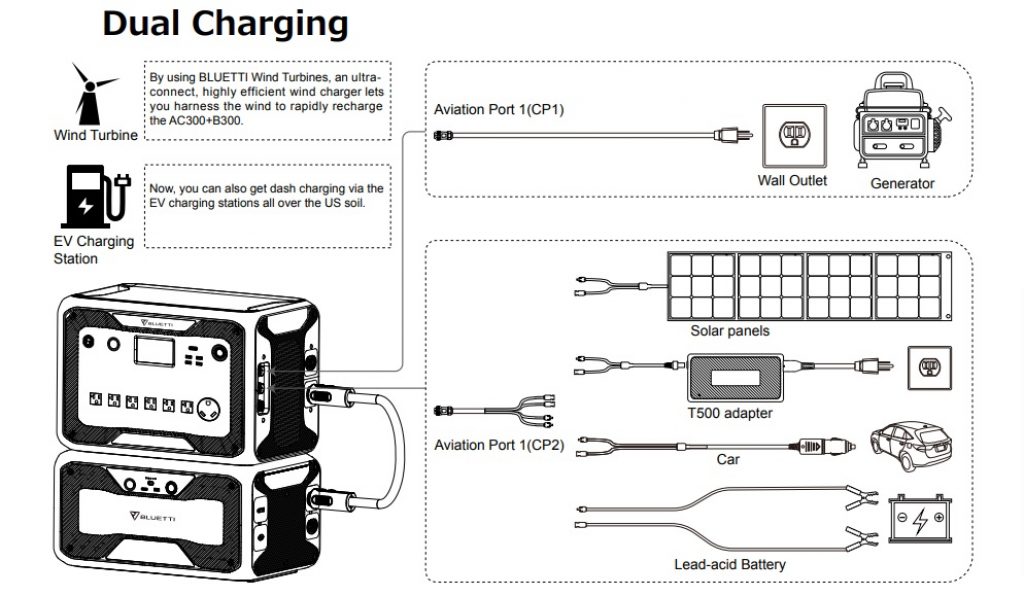
Source: bluettipower.com
Therefore, you can recharge your AC300 with both the wall outlet and solar panels plugged in (considerably speeding up the recharging process) with a total input rate of 5400 W. This way, the estimated recharging time would be anything from 1.6 hours to 2.1 hours.
In general, high-capacity solar generators that have the dual charging feature can be fully recharged in approximately two hours.
How To Maintain Your Home’s Solar Generator?
Here’s a list of maintenance and storage instructions:
- Storage: always store your solar generator unit turned off and charged between 50% and 70% state of charge. If you store the unit for an extended period, you should fully discharge and recharge it at least once every 6 months.
- Environment: avoid exposing your solar generator to rain or harsh/wet environments. Keep the unit away from any combustible materials or gases.
- Temperature: safe charging temperatures range from 0 ºC (32ºF) to 45ºC (113ºF).
- Cleaning: if cleaning is necessary, use non-abrasive cloths to clean your unit.
- Ventilation: keep your solar generator in a well-ventilated area in use or store.
- Self-discharge: if you store the unit for an extended period, you should fully discharge and recharge it at least once every 6 months.
- Battery lifecycle: to ensure the unit’s battery lifecycle, respect the recommended depth of discharge.
Final Thoughts
Solar generator for houses are an excellent option for those who want to prepare for power outages or natural disasters.
Many solar generator models can have their capacity expanded by adding compatible battery modules. This way, they can offer a high energy capacity, capable of powering many home appliances for a fair amount of time.
They aren’t only beneficial to you and your family during emergency situations; they also benefit the environment with their ability to harness energy from the sun.

